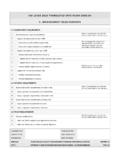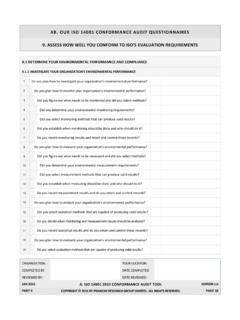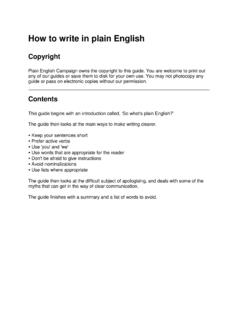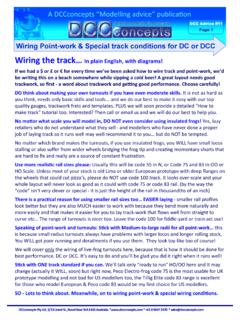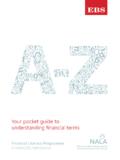Transcription of ISO 9001 2015 in Plain English - praxiom.com
1 I S O 9 0 0 1 2 0 1 5 T R A N S L A T E D I N T O P L A I N E N G L I S H 4. C O N T E X T ORGANIZATION: YOUR LOCATION: COMPLETED BY: DATE COMPLETED: REVIEWED BY: DATE REVIEWED: OCT 2015 Plain English QUALITY MANAGEMENT STANDARD EDITION PART 4 COPYRIGHT 2015 BY PRAXIOM RESEARCH GROUP LIMITED. ALL RIGHTS RESERVED. PAGE 38 UNDERSTAND YOUR ORGANIZATION AND ITS UNIQUE CONTEXT 1 Identify and understand your organization's context. An organization s context is its business environment. It includes all of the internal and external factors and conditions that affect its products and services, have an influence on its QMS, and are relevant to its purpose and strategic direction.
2 An organization s ex ternal c onte xt includes the needs and expectations of its interested parties, as well as its social, cultural, legal, technological, regulatory, and competitive environment. An organization s internal context includes its values, culture, knowledge, and performance. "Iss ue s ca n i ncl u d e p osi ti ve an d neg ati ve fact or s or c o ndi ti ons ". The new standar d expects you to consider your organization s internal and exter nal context w hen you define the scope of its QMS and when you plan its design and development. A quality management system (QMS) is a set of interrelated or interacting elements that organizations use to formulate quality pol i ci es and quali ty objecti ves and to establish the processes that are needed to ensure that policies are followed and objectives are achieved.
3 These elements include structures, programs, procedures, practices, plans, rules, roles, responsibilities, relati onships, contracts, agr eements, documents, r ecor ds, methods, tools, techniques, technologies, and resources. 2 Identify and understand your organization's context before you establish its quality management system (QMS). 3 Consider the external issues that are relevant to your organization's purpose and strategic direction and think about the influence these issues could have on its QMS and the results it intends to achieve. 4 Consider your organization's external environment and think about how it could influence its QMS.
4 5 Consider your legal environment and think about the impact it could have on QMS performance. 6 Consider your social environment and think about the impact it could have on QMS performance. 7 Consider your cultural environment and think about the impact it could have on QMS performance. 8 Consider your market environment and think about the impact it could have on QMS performance. 9 Consider your economic environment and think about the impact it could have on QMS performance. 10 Consider your competitive environment and think about the impact it could have on QMS performance.
5 11 Consider your technological environment and think about the impact it could have on QMS performance. 12 Consider the internal issues that are relevant to your organization's purpose and strategic direction and think about the influence these issues could have on its QMS and the results it intends to achieve. 13 Consider your organization's values and think about their impact. 14 Consider your organization's culture and think about its impact. 15 Consider your organization's knowledge and think about its impact. I S O 9 0 0 1 2 0 1 5 T R A N S L A T E D I N T O P L A I N E N G L I S H 4.
6 C O N T E X T ORGANIZATION: YOUR LOCATION: COMPLETED BY: DATE COMPLETED: REVIEWED BY: DATE REVIEWED: OCT 2015 Plain English QUALITY MANAGEMENT STANDARD EDITION PART 4 COPYRIGHT 2015 BY PRAXIOM RESEARCH GROUP LIMITED. ALL RIGHTS RESERVED. PAGE 39 16 Consider your organization's performance and think about its impact. 17 Monitor information about your organization's context. 18 Consider the impact changes in context could have on your organization's quality management system (QMS). 19 Monitor and review the external issues that could influence your QMS.
7 20 Monitor and review the internal issues that could influence your QMS. CLARIFY THE NEEDS AND EXPECTATIONS OF INTERESTED PARTIES 21 Identify the parties who affect or could affect your QMS. 22 Consider how these interested parties affect or could affect your ability to provide products and services that meet customer requirements. An interested party is anyone who can affect, be affected by, or beli eve that they are affected by a decision or activity. An interested party is a person, group, or organization that has an interest or a stake in a decision or activity.
8 23 Consider how these interested parties affect or could affect your ability to provide products and services that meet all relevant statutory and regulatory requirements. 24 Clarify and understand their unique needs and expectations. 25 Figure out how their needs, expectations, and requirements could influence the performance of your organization's QMS. 26 Monitor and review information about your interested parties. 27 Monitor their changing needs, expectations, and requirements. 28 Review their changing needs, expectations, and requirements. DEFINE THE SCOPE OF YOUR QUALITY MANAGEMENT SYSTEM 29 Clarify boundaries and think about what your QMS should apply to.
9 When we use the word section or clause, we re referring to the original standard; and when we use the word part, we re referring to our Plain English publication. 30 Use boundary and applicability information to define the scope of your QMS. 31 Consider your organization's context when you define your scope. Your context was discussed in part 32 Consider how external issues could influence your QMS. 33 Consider the impact your external environment could have. I S O 9 0 0 1 2 0 1 5 T R A N S L A T E D I N T O P L A I N E N G L I S H 4. C O N T E X T ORGANIZATION: YOUR LOCATION: COMPLETED BY: DATE COMPLETED: REVIEWED BY: DATE REVIEWED: OCT 2015 Plain English QUALITY MANAGEMENT STANDARD EDITION PART 4 COPYRIGHT 2015 BY PRAXIOM RESEARCH GROUP LIMITED.
10 ALL RIGHTS RESERVED. PAGE 40 34 Consider the impact your legal environment could have. 35 Consider the impact your social environment could have. 36 Consider the impact your cultural environment could have. 37 Consider the impact your market environment could have. 38 Consider the impact your economic environment could have. 39 Consider the impact your competitive environment could have. 40 Consider the impact your technological environment could have. 41 Consider how internal issues could influence your QMS. 42 Consider the impact your organization's values could have.
